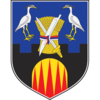Pećinci (Serbian Cyrillic: Пећинци, Glagolitic script: Ⱂⰵⱋⰻⱀⱌⰻ, pronounced [pětɕiːntsi]; Hungarian: Pecsince) is a village and municipality located in the Srem District of the autonomous province of Vojvodina, Serbia. The village has a population of 2,448, while Pećinci municipality has 18,401 inhabitants (2022 census).
Pećinci
Пећинци, Ⱂⰵⱋⰻⱀⱌⰻ (Serbian) | |
|---|---|
Village and municipality | |
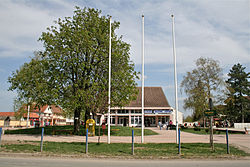 | |
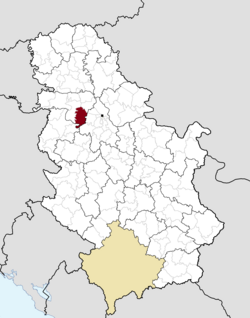 Location of the municipality of Pećinci within Serbia | |
| Coordinates: 44°54′N 19°58′E / 44.900°N 19.967°E | |
| Country | |
| Province | |
| District | Srem |
| Settlements | 15 |
| Government | |
| • Mayor | Siniša Đokić (SNS) |
| Area | |
| • Municipality | 488.72 km2 (188.70 sq mi) |
| • Village | 19.27 km2 (7.44 sq mi) |
| Elevation | 83 m (272 ft) |
| Population (2022)[2] | |
| • Municipality | 18,401 |
| • Density | 38/km2 (98/sq mi) |
| • Village | 2,448 |
| Time zone | UTC+1 (CET) |
| • Summer (DST) | UTC+2 (CEST) |
| Postal code | 22410 |
| Area code | +381(0)22 |
| Vehicle registration | RU |
| Website | www |
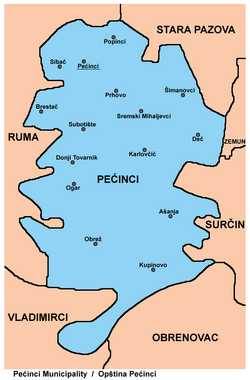
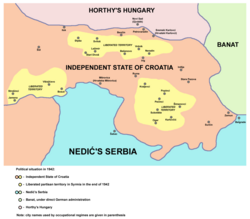
Name
editIn Serbo-Croatian, the village is known as Pećinci (Пећинци/Ⱂⰵⱋⰻⱀⱌⰻ), in Hungarian as Pecsince, in German as Petschinzi, in Slovak as Pečinci, and in Rusyn as Печинци. Its name derived from the Serbian word "peć/пећ/ⱂⰵⱋ" ("furnace" in English), or "petlja/петља/ⱂⰵⱅⰾⱜⰰ" ("loop" or "noose" in English). The name of the village in Serbo-Croatian is plural.
History
editThe village was first time recorded by the sources in 1416. After that time, there were no other records about this settlement until 1702. The village was under Ottoman administration until the Treaty of Passarowitz (1718), when it passed to Habsburg monarchy. During Habsburg administration, it was part of the Habsburg Military Frontier. From 1848 to 1849, the village was part of Serbian Vojvodina, but was again included into Military Frontier in 1849. After abolishment of the frontier (in 1882), it was included into Syrmia County of Croatia-Slavonia, which was an autonomous kingdom within the Kingdom of Hungary and Austria-Hungary. According to the 1910 census, the village had a Serb ethnic majority.
In 1918, the village first became part of the State of Slovenes, Croats and Serbs, then part of the Kingdom of Serbia, and finally part of the newly formed Kingdom of Serbs, Croats and Slovenes (later renamed to Yugoslavia). From 1918 to 1922, the village was part of the Syrmia County, from 1922 to 1929 part of the Syrmia oblast, and from 1929 to 1941 part of the Danube Banovina. From 1941 to 1944, the village was occupied by the Axis Powers and was attached to Pavelić's Independent State of Croatia. Territory of present-day Pećinci municipality was an important center of partisan resistance movement and a partisan liberated territory was formed in this area during the war.
After the war, the village became part of Vojvodina, an autonomous province of the Socialist Republic of Serbia and Socialist Federative Republic of Yugoslavia. Until 1960, villages of present-day Pećinci municipality were part of the municipalities of Ruma, Stara Pazova and Zemun (village of Pećinci itself was part of Zemun municipality). A separate municipality of Pećinci was formed in 1960 and the village of Pećinci was chosen to be the municipal center because of its favorable traffic position.
Inhabited places
editAside from the village of Pećinci, municipality includes the following villages:
Demographics
edit| Year | Pop. | ±% p.a. |
|---|---|---|
| 1948 | 18,800 | — |
| 1953 | 18,567 | −0.25% |
| 1961 | 19,289 | +0.48% |
| 1971 | 18,490 | −0.42% |
| 1981 | 19,284 | +0.42% |
| 1991 | 20,077 | +0.40% |
| 2002 | 21,560 | +0.65% |
| 2011 | 19,720 | −0.99% |
| 2022 | 18,401 | −0.63% |
| Source: [3] | ||
According to the 2011 census results, the municipality had 19,720 inhabitants.
Ethnic groups
editAll settlements in the municipality have an ethnic Serb majority. The ethnic composition of the municipality:[4]
| Ethnic group | Population | % |
|---|---|---|
| Serbs | 17,965 | 91.1% |
| Romani | 1,008 | 5.11% |
| Slovaks | 79 | 0.4% |
| Croats | 42 | 0.21% |
| Macedonians | 33 | 0.17% |
| Montenegrins | 22 | 0.11% |
| Yugoslavs | 22 | 0.11% |
| Hungarians | 21 | 0.11% |
| Muslims | 11 | 0.06% |
| Russians | 11 | 0.06% |
| Bosniaks | 11 | 0.06% |
| Others | 495 | 2.51% |
| Total | 19,720 |
Economy
editThe following table gives a preview of total number of registered people employed in legal entities per their core activity (as of 2018):[5]
| Activity | Total |
|---|---|
| Agriculture, forestry and fishing | 201 |
| Mining and quarrying | 4 |
| Manufacturing | 3,380 |
| Electricity, gas, steam and air conditioning supply | 11 |
| Water supply; sewerage, waste management and remediation activities | 51 |
| Construction | 119 |
| Wholesale and retail trade, repair of motor vehicles and motorcycles | 1,934 |
| Transportation and storage | 400 |
| Accommodation and food services | 144 |
| Information and communication | 107 |
| Financial and insurance activities | 13 |
| Real estate activities | 4 |
| Professional, scientific and technical activities | 118 |
| Administrative and support service activities | 84 |
| Public administration and defense; compulsory social security | 162 |
| Education | 288 |
| Human health and social work activities | 207 |
| Arts, entertainment and recreation | 32 |
| Other service activities | 52 |
| Individual agricultural workers | 393 |
| Total | 7,706 |
See also
editReferences
edit- ^ "Municipalities of Serbia, 2006". Statistical Office of Serbia. Retrieved 2010-11-28.
- ^ "Census 2022: Total population, by municipalities and cities". popis2022.stat.gov.rs.
- ^ "2011 Census of Population, Households and Dwellings in the Republic of Serbia" (PDF). stat.gov.rs. Statistical Office of the Republic of Serbia. Retrieved 19 August 2017.
- ^ "ETHNICITY Data by municipalities and cities" (PDF). stat.gov.rs. Statistical Office of the Republic of Serbia. Retrieved 22 February 2018.
- ^ "MUNICIPALITIES AND REGIONS OF THE REPUBLIC OF SERBIA, 2019" (PDF). stat.gov.rs. Statistical Office of the Republic of Serbia. 25 December 2019. Retrieved 28 December 2019.
